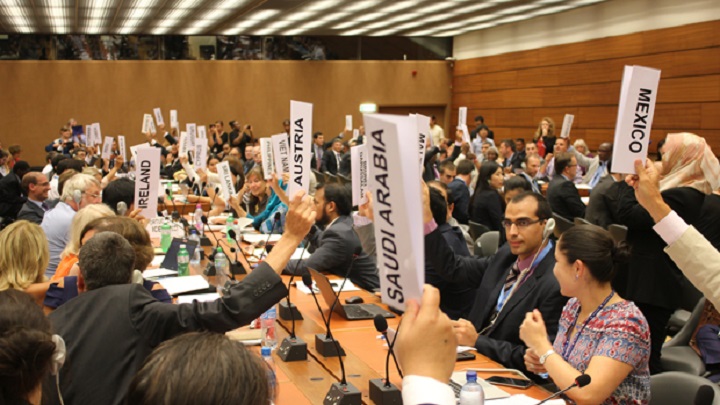We are facing “the beginning of the elimination of nuclear weapons.”
On January 22, the Treaty of the Prohibition of Nuclear Weapons (TPNW) will enter into force. It will specifically prohibit States Parties from developing, testing, producing, manufacturing, acquiring, possessing, deploying, using or threatening to use nuclear weapons and assisting or encouraging such acts. The treaty will reinforce existing international law that obliges all states not to test, use or threaten the use of nuclear weapons.
For World without Wars and Violence it is reason to hold a great celebration because it is from now on that there really is a legal instrument in the international arena that specifies the aspirations that for decades have been overshadowed in many countries and citizens of the planet.
The preamble to the TPNW highlights the risks posed by the existence of nuclear weapons and the catastrophic humanitarian consequences that would result from their use. States that have ratified the treaty and those that have acceded highlight this danger and consequently define their commitment towards a world free of nuclear weapons.
To this positive and enthusiastic start we must now add that the ratifying states develop and approve legislation that implements the spirit of the agreement: including prohibitions on the transit and financing of nuclear weapons. Only prohibiting financing, putting an end to investments in the nuclear weapons industry, would have a high symbolic and effective value, of great significance in the nuclear arms race.
Now the path is set and we aspire for the number of countries that support the TPNW to increase in an unstoppable trickle. Nuclear weapons are no longer a symbol of technological progress and power, now they are a symbol of oppression and danger for humanity, first of all, for the citizens of the countries themselves with nuclear weapons. Because the nuclear weapons of an “enemy” are aimed at the cities of other countries that possess them, not those that do not. Nuclear weapons are weapons created and designed to create terror. Their targets are big cities.
The TPNW has been achieved as a result of 75 years of nuclear disarmament activism by civil society since the nuclear bombings of Hiroshima and Nagasaki demonstrated the catastrophic humanitarian impact of nuclear weapons. It has been the collectives, organizations and movements, with the support of mayors, parliamentarians and governments sensitized to this issue, that have continued to fight these years up to the present time. Nevertheless, this has not stopped the nuclear arms race by the great powers.
In all these years, important steps have been taken such as: the treaties to prohibit nuclear tests, the reduction of the number of nuclear weapons, the generalized non-proliferation of nuclear weapons and the prohibition of them in more than 110 countries through nuclear-weapon-free zones (Treaties of: Tlatelolco, Rarotonga, Bangkok, Pelindaba, Central Asian Nuclear Weapon-Free zone, Mongolia’s Nuclear-Weapon-Free zone, Antarctic, Outer Space and the Sea Bed).
The theory of deterrence has failed because although nuclear weapons haven’t been used in armed conflicts, the Doomsday Clock coordinated by scientists and Nobel laureates indicates that we are 100 seconds away from atomic conflict. The possibility increases year after year that nuclear weapons will be used by accident, conflict escalation, miscalculation or malicious intent. This option is possible as long as the weapons exist and are part of “security” doctrines.
The nuclear weapon states will eventually have to accept their obligations to achieve nuclear disarmament. They agreed on this in the first resolution of the United Nations, Resolution 1 (1) of the UNGA, adopted on January 24, 1946 by consensus. Also, in Article VI of the Non-Proliferation Treaty they committed themselves to working for nuclear disarmament as States Parties. Furthermore, all states are bound by customary-based international laws and treaties that prohibit the threat or use of nuclear weapons, as affirmed by the International Court of Justice in 1996 and the UN Human Rights Committee in 2018. The entry into force of the TPNW and the 75th anniversary of Security Council Resolution 1 (1), two days later, provides an opportune moment to remind all states of the illegality of the threat or use of nuclear weapons and their obligations on nuclear disarmament, and to draw attention to implement them immediately.
 On January 23, the day after TPWN entries into force, World without Wars and Violence, a member of ICAN, will hold a Cultural Cyberfestival celebrating “A great step for humanity.” During more than 4 hours we will revive some of the concerts, statements, activities against nuclear weapons and activities for peace in the world. The idea is to repeat it in the future each time a group of countries joins the TPNW.
On January 23, the day after TPWN entries into force, World without Wars and Violence, a member of ICAN, will hold a Cultural Cyberfestival celebrating “A great step for humanity.” During more than 4 hours we will revive some of the concerts, statements, activities against nuclear weapons and activities for peace in the world. The idea is to repeat it in the future each time a group of countries joins the TPNW.
It’s time to end the era of nuclear weapons!
The future of humanity will only be possible without nuclear weapons!
i A Military Staff Committee shall be established to “to advise and assist the Security Council on all questions relating to the Security Council’s military requirements for the maintenance of international peace and security, the employment and command of forces placed at its disposal, the regulation of armaments, and possible disarmament.”
![]()
World Coordination Team of World without Wars and Violence












